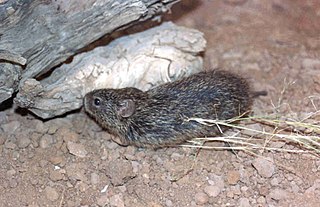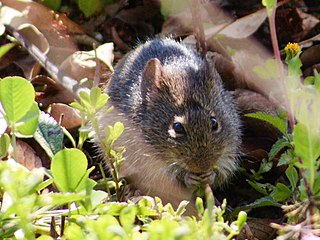
A cotton rat is any member of the rodent genus Sigmodon. Their name derives from their damaging effects on cotton as well as other plantation crops, such as sugarcane, corn, peanut and rice. Cotton rats have small ears and dark coats, and are found in North and South America. Members of this genus are distributed in the Southwestern United States, Mexico, Central America, and South American countries of: Venezuela, Ecuador, Colombia, Peru, Brazil, Guyana, and Suriname. Many of the species are found in Mexico.

The white-eared honeyeater is a medium-sized honeyeater found in Australia. It is a member of the family Meliphagidae which has 190 recognised species with about half of them found in Australia. This makes them members of the most diverse family of birds in Australia. White-eared honeyeaters are easily identifiable by their olive-green body, black head and white ear-patch.

The white-eared hummingbird is a species of hummingbird in the "emeralds", tribe Trochilini of subfamily Trochilinae. It is found from the southwestern U.S. to Nicaragua.
Hooper's mouse is a species of rodent in the family Cricetidae. It is the only member of the Peromyscus hooperi species group, and is found only in Mexico. The species is named for Emmett Hooper, a researcher into the taxonomy of the genus Peromyscus.
Allen's cotton rat is a species of rodent in the family Cricetidae. It is endemic to western Mexico, where its distribution extends from Sinaloa to Oaxaca. The formerly recognized S. planifrons and S. vulcani are now considered conspecific with S. alleni by the IUCN.

The Arizona cotton rat or Colorado River cotton rat is a species of rodent in the family Cricetidae. It is found in Mexico and the United States.

The tawny-bellied cotton rat is a species of rodent in the family Cricetidae. It is found in Mexico and in the US states of Arizona and New Mexico.
The unexpected cotton rat is a species of rodent in the family Cricetidae. It is found only in Ecuador at elevations of 3500 to 4000 m, where it has been found in association with streams and marshes. It is also known as the Ecuadorian cotton rat.

The Jaliscan cotton rat or Mexican cotton rat is a species of rodent in the family Cricetidae. It is found only in Mexico. They commonly have brown fur with white fur on the belly. They are ground-dwelling and prefer open habitats.

The yellow-nosed cotton rat is a species of rodent in the family Cricetidae. It is native to Mexico and to the states of Arizona, New Mexico, and Texas in the United States, where it inhabits mountain grassland, scrub, and pinyon-juniper woodland. It is common over much of its wide range and the IUCN considers it to be of "least concern".
The Peruvian cotton rat is a species of rodent in the family Cricetidae. It is found in Ecuador and Peru.

The white-eared brown dove is a species of bird in the family Columbidae. It is endemic to the Philippines.

The white-eared monarch, or white-eared flycatcher, is a species of bird in the family Monarchidae. It is endemic to north-eastern Australia. Its natural habitat is subtropical or tropical moist lowland forests. The white-eared monarch was originally described in the genus Monarcha until moved to Carterornis in 2009.

The white-necked babbler is a species of bird in the family Timaliidae. It is found in Brunei, Indonesia, Malaysia, and Thailand. Its natural habitat is subtropical or tropical moist lowland forest. It is threatened by habitat loss.

The white-eared jacamar is a species of bird in the family Galbulidae. It is found in Brazil, Colombia, Ecuador and Peru.

The white-eared barbet is a species of bird in the family Lybiidae . It is found in Eswatini, Kenya, Malawi, Mozambique, South Africa, Tanzania, and Zimbabwe.

The Palawan fruit bat, also known as the Palawan flying fox, is a species of megabat found in forests of Palawan, Balabac and Busuanga in the Philippines. It is listed as vulnerable by the IUCN and is declining due to hunting and habitat loss.
The Toltec cotton rat is a rodent species in the family Cricetidae. It is found in eastern Mexico from the Rio Grande to the Yucatán Peninsula, as well as in Belize and northern Guatemala. It prefers moist grassland habitat. While long thought to be a subspecies of S. hispidus, recent taxonomic revisions, based on mitochondrial DNA sequence data, have split the extensive former species range into three separate species. Carroll et al. (2004) indicate that the southern edge of the S. hispidus distribution is likely near the Rio Grande where it meets the northern distribution of S. toltecus. The range of S. toltecus extends from northern Mexico south into Chiapas where it occurs in sympatry with S. hirsutus . Rats from this species group have been used as laboratory animals.

The southern cotton rat is a rodent species in the family Cricetidae. It is found from southern Chiapas in Mexico through Central America, except for Belize, and as far east as northern Colombia and Venezuela. It lives in tropical rainforest, dry forest and savanna, as well as in cultivated areas. The species is terrestrial and primarily diurnal. It was long thought to be a subspecies of S. hispidus. However, recent taxonomic revisions, based on mitochondrial DNA sequence data, have split the extensive former species range into three separate species. Carroll et al. (2004) indicate that the southern edge of the S. hispidus distribution is likely near the Rio Grande where it meets the northern distribution of S. toltecus. The range of S. toltecus extends from northern Mexico south into Chiapas where it occurs in sympatry with S. hirsutus . Rats from this species group have been used as laboratory animals.
The Miahuatlán cotton rat was formerly considered a rodent species in the family Cricetidae. It is found only on the Pacific slope of the Sierra de Miahuatlán in the Mexican state of Oaxaca, where it lives in deciduous tropical forest. The IUCN currently considers it to be conspecific with Sigmodon alleni.














